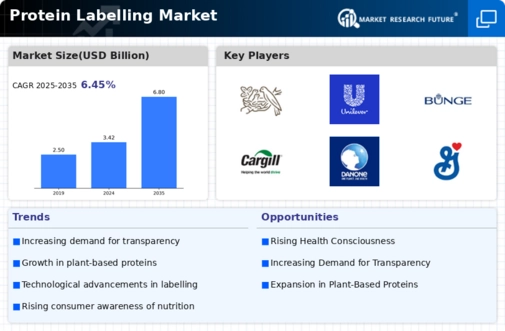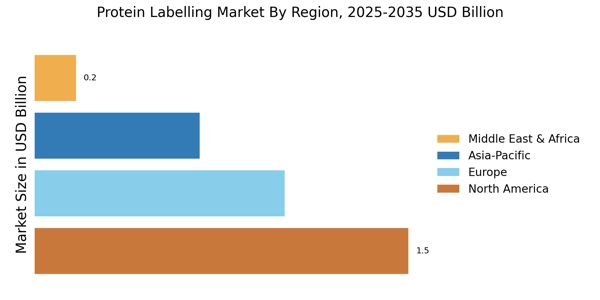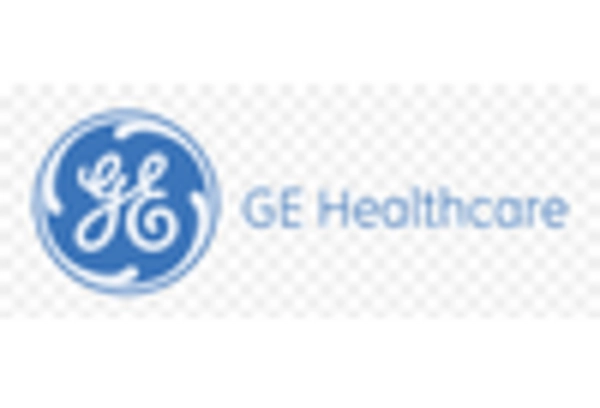Regulatory Compliance and Standards
The Protein Labelling Market is significantly influenced by the evolving landscape of regulatory compliance and standards. Governments and health organizations are increasingly implementing stringent regulations regarding food labelling, particularly concerning protein content. These regulations aim to ensure that consumers receive accurate information about the nutritional value of products. For instance, recent mandates require clearer declarations of protein sources and amounts, compelling manufacturers to adapt their labelling strategies. This regulatory environment not only fosters consumer trust but also drives innovation within the industry. As companies strive to meet these standards, the Protein Labelling Market is poised for growth, with an emphasis on transparency and accuracy in nutritional information.
Growth of Health and Wellness Trends
The Protein Labelling Market is benefiting from the broader growth of health and wellness trends. As individuals increasingly prioritize fitness and nutrition, the demand for high-protein products has surged. This trend is particularly evident in sectors such as sports nutrition and functional foods, where consumers seek products that support their health goals. Market data indicates that the protein supplement segment alone is projected to reach a valuation of over 20 billion dollars by 2026. This growing interest in protein-rich diets compels manufacturers to enhance their labelling practices, ensuring that consumers can easily identify high-protein options. Consequently, the Protein Labelling Market is likely to thrive as brands align their offerings with consumer health aspirations.
Innovation in Labelling Technologies
The Protein Labelling Market is witnessing a wave of innovation in labelling technologies, which is reshaping how nutritional information is presented to consumers. Advances in digital printing, smart labels, and augmented reality are enabling brands to provide more engaging and informative labelling experiences. For instance, smart labels can offer real-time information about protein content and sourcing, enhancing consumer interaction with products. This technological evolution not only improves the accuracy of labelling but also aligns with consumer expectations for transparency and engagement. As these innovations gain traction, the Protein Labelling Market is likely to see increased investment in technology-driven solutions that enhance the consumer experience and foster brand loyalty.
Rise of E-commerce and Online Shopping
The Protein Labelling Market is experiencing a transformation due to the rise of e-commerce and online shopping. As consumers increasingly turn to digital platforms for their grocery needs, the importance of clear and informative labelling becomes paramount. Online shoppers often rely on product descriptions and nutritional information to make purchasing decisions, making effective labelling a critical factor in attracting customers. Data suggests that e-commerce sales in the food sector have grown by over 30% in recent years, highlighting the need for brands to optimize their labelling for online visibility. This shift not only enhances consumer access to protein products but also drives competition among brands to provide superior labelling in the Protein Labelling Market.
Consumer Demand for Nutritional Information
The Protein Labelling Market is experiencing a surge in consumer demand for detailed nutritional information on food products. As health consciousness rises, consumers are increasingly scrutinizing labels to make informed dietary choices. This trend is reflected in the growing preference for products that clearly indicate protein content, sources, and nutritional benefits. According to recent data, approximately 70% of consumers actively seek out protein information on labels, indicating a significant shift in purchasing behavior. This heightened awareness drives manufacturers to enhance their labelling practices, ensuring compliance with regulations while catering to consumer preferences. Consequently, the Protein Labelling Market is likely to expand as brands invest in clearer, more informative labelling to meet this demand.


















Leave a Comment